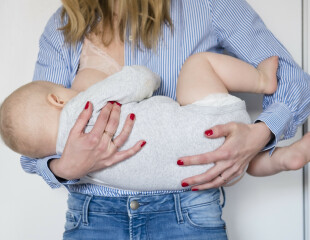
Key rules for storing breast milk
Continuing to breastfeed baby even though you are not there? It is possible! You can express your milk using a breast pump or by hand, collect it and take it with you wherever you go. This is an overview of the steps to adhere to for optimal storage of breast milk.
The right breast pump
Going back to work, being separated from baby, swollen breasts… there are lots of different reasons for using a breast pump. A breast pump is a practical device which has the advantage of substituting baby’s sucking action and thereby stimulates lactation.
- For occasional use
This manual breast pump is perfect for you! It takes up no room, is discreet and is easily transportable. Ideal if you are only expressing milk occasionally.
On the other hand, watch out for cramps! The manual system requires you to action the trigger several times in order to work.
- For regular use
For daily use, an electric breast pump is a preferable option. Breast pumps can be hired from pharmacies or online on the Grandir Nature website.
Rental is partially covered by French health insurance. Contact your insurance provider for more information.
- To increase milk production or save time
The double pump breast milk expresses milk from both breasts simultaneously. It makes it possible to express more, and in record time! It also has the benefit of increasing milk production when baby is absent.

I express my milk manually
No breast pump immediately available? Try out manually expressing your milk!
To do this, place your thumb, index and middle finger about 3cm behind the nipple. Press gently whilst squeezing. Gradually move your fingers closer together without actually sliding them over the skin (risk of pain) until there is no more milk. Repeat this movement around the entire breast.
Storage rules
Take note ! These storage rules must be adhered to at all times:
- At room temperature, between 19°c and 22°C, milk that has just been expressed can be stored for a maximum of 1 hour.
- In the fridge, at a temperature below or equal to 4°C, milk can be stored for 48 hours.
- In the freezer, at -18°C, milk can be stored for 4 months. Once defrosted, milk must be consumed within 24 hours. Warning! It must never be refrozen !
EXPERT ADVICE:
Which recipients should I use to store my milk?
Choose plastic kits that have been designed especially for this purpose because they do not contain bisphenol A. Glass can also be used, but there is a risk of breakage.
Also remember to make a note on each pot of the date and time that your expressed the milk to ensure that you always give baby quality milk !
I transport my milk with peace of mind
If you need to go out, use an isotherm bag with a freezer block or a cool box to transport the milk. Temperature must be kept at a maximum of 15°C for no more than an hour, or at +4°C.
Absolute principle: never, ever break the cold chain !
I gently warm the milk
Start by gently warming the milk through. Bain-marie, bottle warmer, under the hot tap…any of these methods will do. Never use the microwave, however: there is risk of burning and a reduction in nutritional quality.
Once milk has been reheated, also test the temperature by tipping a few drops onto your forearm.
Reheated milk should be consumed within 30 minutes. If any is left over, dispose of it.












